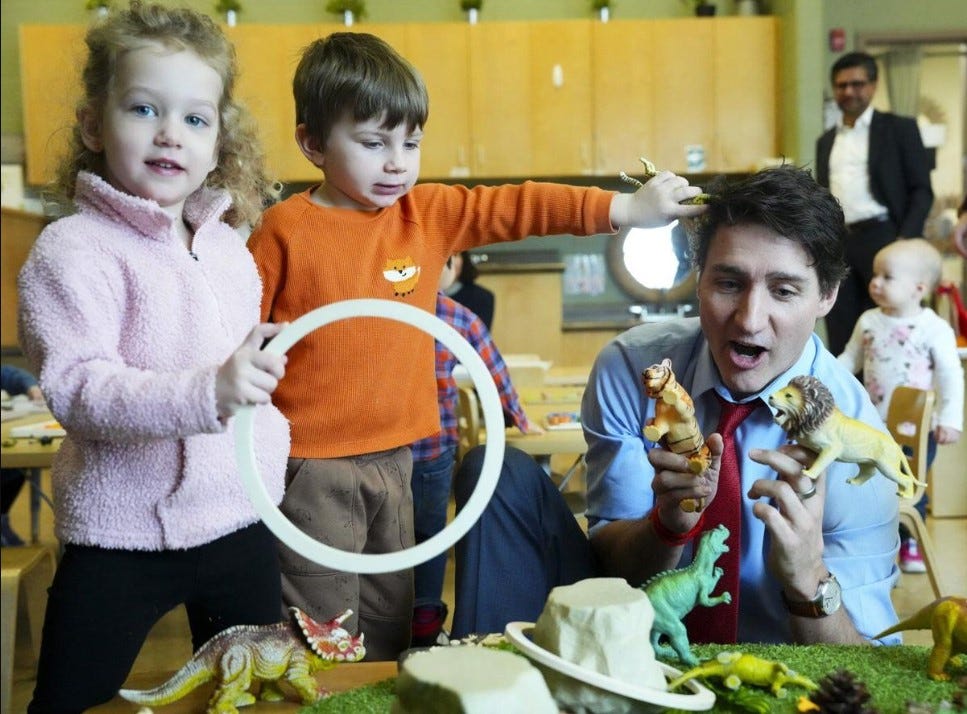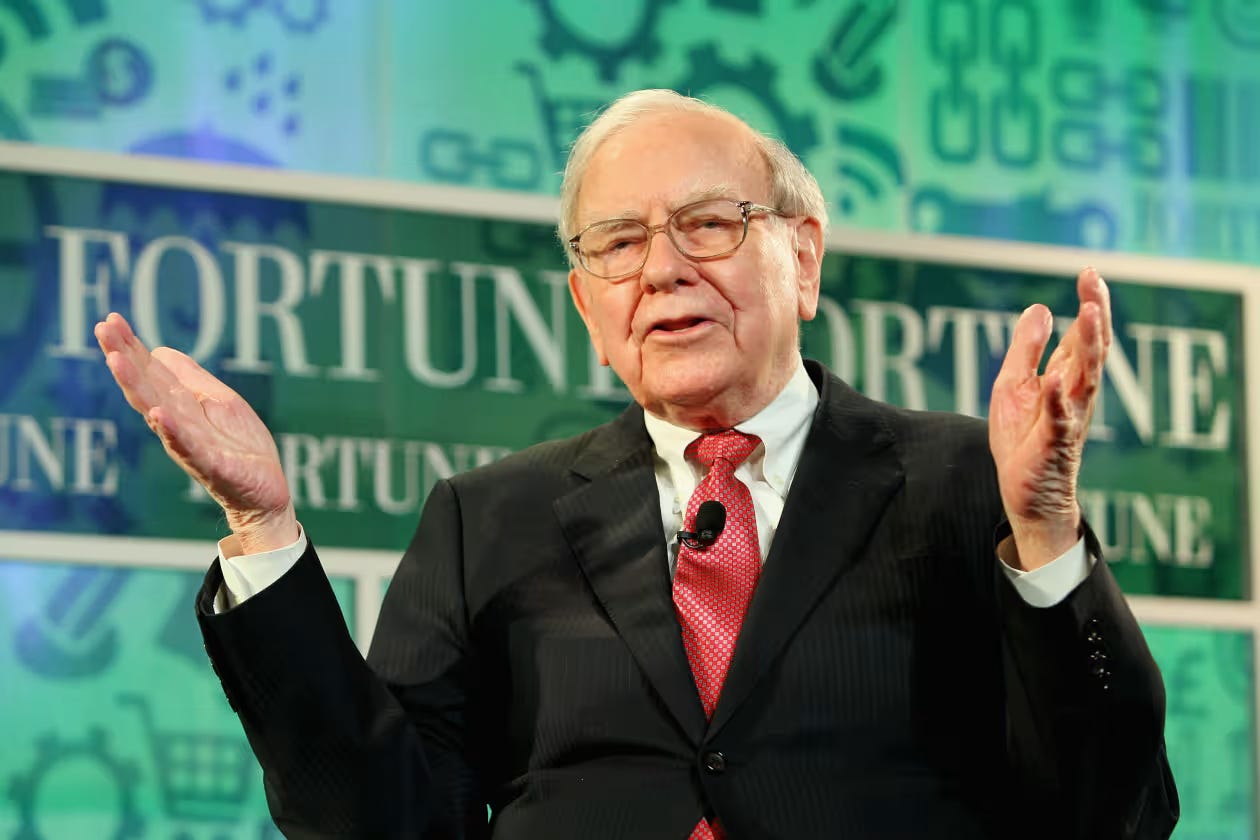Good morning, it’s Thursday, October 2nd. In today’s news, Canada’s $10-a-day childcare dream is collapsing, Liberals push bill giving Ottawa power to cut off your internet without a warrant, Alberta separatists claim cabinet-level meeting with Trump officials, US government shuts down after stopgap funding bill fails, and much more.
First time reading the daily blend? Sign up here.
Canada’s $10-a-Day Daycare Dream Is Collapsing Under Its Own Weight
Canada’s push to build a universal $10-a-day daycare program was sold as a solution to affordability, access, and equity. Instead, Ontario’s Auditor General has revealed a system that looks more like a cautionary tale in what happens when government promises outpace reality.
The report paints a picture of mismanagement, misplaced priorities, and looming financial instability. While the province set a goal of creating 48,000 new child-care spaces by 2024, only about 36,000 were added—roughly 75% of the target. At the same time, the very families the program was supposed to help most have been pushed out. Since 2019, enrolment among lower-income families receiving fee subsidies has dropped by 31%. Demand surged when parent fees fell, but with limited capacity and no effective wait-list system, vulnerable families are being squeezed out.
Even when new spaces exist, they aren’t always being used. As of late 2023, more than 80,000 daycare spots were sitting empty, either vacant or not operational. Almost half of all centres reported running below 80% of their licensed capacity. Yet the Ministry doesn’t even track why so many spots go unused, leaving the system blind to inefficiencies that could be corrected.
Affordability, the program’s core selling point, is also under threat. Ontario burned through its five-year federal allocation in just four years. By 2026-27, the province is staring down a funding shortfall of nearly $2 billion. Without a major cash injection, parents should expect fees to rise again. The much-touted $10/day promise looks increasingly like a mirage.
Then there’s the workforce crisis. Early Childhood Educators are the backbone of the system, but Ontario has not met its 60% RECE staffing target. The province may need up to 10,000 additional qualified educators by 2026—an almost impossible feat given current recruitment and retention struggles.
What’s left is a program that satisfies neither parents nor taxpayers. Families face wait lists, empty promises, and uncertainty over rising costs. Taxpayers face the reality of billions more being required to prop up a system already buckling under its own contradictions.
If current trends continue, Canada’s socialized daycare experiment will end the way many state-engineered systems do: underfunded, understaffed, and failing the very people it was designed to serve. Source.
Liberals Push Bill Giving Ottawa Power to Cut Off Your Internet Without a Warrant
Bill C-8, now before Parliament, would hand Ottawa sweeping new powers over Canadians’ internet access. Buried within the bill is a clause amending the Telecommunications Act, which hands the industry minister—now Mélanie Joly—the authority to order telecom giants like Rogers or Telus to cut off internet access for “any specified person.” No warrant, no court approval, no oversight before the fact. A citizen could be cut off from the online world entirely on the minister’s say-so, with judicial review only possible after the order is executed.
The Carney government justifies the bill as a tool to defend against cyber-attacks, hackers, and foreign interference. Public Safety Minister Gary Anandasangaree argues it’s about stopping ransomware and hostile state actors. But the scope goes far beyond that. The bill allows the government to direct telecoms to “do anything or refrain from doing anything,” wording critics say could be used to impose mass surveillance, weaken encryption, or force companies to hand over data on Canadians without their knowledge.
This is not an isolated measure. Bill C-8 follows a series of Liberal-championed laws that have steadily tightened federal control over the digital sphere:
The Online News Act (2023) forced social media platforms into deals with news outlets and led Facebook to ban news sharing in Canada altogether.
The Online Streaming Act (2023) put podcasts, YouTubers, and streaming platforms under Canadian content rules — requiring platforms to artificially boost some content while burying others.
While Canada has signed international declarations that internet access is a fundamental human right and even helped found the Freedom Online Coalition to oppose state restrictions, the government is now moving in the opposite direction—claiming emergency powers to decide who can access the internet at all.
Bottom line:
Bill C-8 isn’t just about cybersecurity. It’s about control. By granting ministers unilateral authority to pull internet access and compel telecoms to cooperate in secret, the bill creates a framework for surveillance, censorship, and political targeting. It puts the very foundation of digital freedom in Canada at risk, and it does so under the guise of “protecting” Canadians.
Alberta Separatists Claim Cabinet-Level Meeting With Trump Officials
This week, Alberta separatists from the Alberta Prosperity Project (APP) claimed a breakthrough: a cabinet-level meeting in Washington, D.C. with members of the Trump administration. According to APP cofounder Jeff Rath, one U.S. official even left their discussion to head directly into the Oval Office. While the White House has made no official commitments, the group interprets this as a signal of serious American interest in Alberta’s independence.
The APP, led by Rath, Mitch Sylvestre, and Dennis Modry, has been lobbying for Alberta sovereignty through both education and political pressure. Their agenda is simple: Alberta should control its own future on taxes, trade, policing, and energy. Frustrations with Ottawa—over pipelines, emissions caps, and perceived economic sabotage—have fed the separatist undercurrent. Rath argues that support for independence is far stronger within the province’s ruling United Conservative Party (UCP) than polls suggest, claiming as much as 75% of the UCP base is sympathetic.
Still, surveys tell a more cautious story. Angus Reid found 36% of Albertans in favour of secession, a meaningful minority but far short of the threshold for a viable referendum. Experts like Adrienne Davidson of McMaster University warn that neither public sentiment nor legal hurdles make independence a near-term possibility. First Nations opposition, constitutional challenges, and the practical realities of negotiating secession with Ottawa remain formidable barriers.
Yet the APP presses on. Its proposed referendum question—“Do you agree that the Province of Alberta shall become a Sovereign Country and cease to be a province in Canada?”—is under judicial review, with a decision expected in November. Should the courts approve, the group plans to begin signature collection to force a province-wide vote.
For Washington, the draw is obvious. Alberta sits on the world’s third-largest oil reserves, and 90% of its exports already head south. A sympathetic U.S. administration could see a breakaway Alberta as a reliable energy partner, especially if Ottawa is viewed as too beholden to climate commitments or foreign influence.
But enthusiasm in Washington does not erase political reality in Edmonton. Premier Danielle Smith has reiterated her goal is a “strong and sovereign Alberta within a united Canada.” For now, Alberta separatism remains more pressure tactic than imminent breakaway—though its growing visibility in both Alberta and Washington is a signal Ottawa can’t ignore. Source.
US Government Shuts Down After Stopgap Funding Bill Fails in the Senate
The US federal government partially shut down at midnight Wednesday after Senate Democrats failed to support a stopgap funding bill, falling five votes short of the 60 needed. Only three Democrats voted in favour. This is the first shutdown since December 2018. How long it will last is uncertain—White House officials say it depends on whether Democrats break their opposition, as previous shutdowns have ranged from a single day to over a month.
The shutdown affects non-essential federal employees, who will either be furloughed or required to work without pay until a deal is reached. Essential workers, including military personnel, air traffic controllers, and postal carriers, continue to work and receive pay, although some payments may be retroactive. Critical programs like Social Security, Medicare, Medicaid, and food assistance through SNAP continue, but services like FEMA, WIC, and other non-essential government functions will be delayed.
President Trump warned that the shutdown could have “irreversible” consequences, including permanent cuts to programs and employees, calling the situation “bad for them and irreversible by them.” More
Alberta to Pay Families, Provide Learning Resources If Teachers Go on Strike
Alberta is preparing for a teachers’ strike set to begin October 6 after 89.5% of teachers rejected the province’s contract offer. The government will provide parents of children 12 and under $150 per week from unspent teacher salary and training funds, and supply at-home learning resources to keep students on track. The rejected offer included a 12% wage increase over four years, hiring 3,000 teachers and 1,500 education assistants, and a unified pay grid giving most teachers a 17% raise. The Alberta Teachers’ Association says the offer doesn’t address classroom complexity or adequately respect teachers, while Premier Danielle Smith calls it “generous.” The strike could disrupt education for over 700,000 students across 2,500 schools. More
Hamas Split on Whether to Back Trump’s Plan to End Gaza War—Seeks Amendments - Sources both within and close to Hamas say they are pushing to change clauses on disarmament and timing of hostages’ release, which are Israel’s key demands for ending the fighting. More
Bomb Threat Shuts Oktoberfest as Munich Police Probe Deadly ‘Family Dispute’ as the Cause - More
Nepal Chooses a 2-Year-Old Girl as New Living Goddess Worshipped by Both Hindus and Buddhists - More
Federal Government Freezes $18 Billion in New York City Infrastructure Projects Over Concerns It Will Be Used to Fund DEI-Focused Projects - More
Germany Arrests Hamas Members Accused of Procuring Weapons to Target Jewish and Israeli Institutions - More
Death Toll rises to 69 After 6.9 Magnitude Earthquake Strikes Central Philippines - More
Buffett Indicator Signals US Economy ‘Playing With Fire’ as Stocks Reach 363% of GDP
The Warren Buffett Indicator, which compares total US stock market capitalization to GDP, has officially reached 217% in mid-2025, well above historical norms and prior peaks, signalling stretched valuations. Some analysts highlight an even more extreme measure—factoring in mega-cap gains, AI hype, and high P/E multiples—which puts total market value at roughly 363% of GDP, far above the 212% dot-com peak. Market gains have far outpaced economic growth (H1 2025 GDP ~1.75%), raising the risk of a correction if earnings or growth slow. AI-related companies alone are valued at $2.7 trillion despite thin revenues.
Buffett has warned that readings above 200% are like “playing with fire,” emphasizing that investors should focus on quality, cash-generating companies and patience rather than chasing overvalued stocks. Analysts recommend diversification into international equities, fixed income, and alternatives as the long US bull market shows signs of cooling. More
Quebec Premier Blanchet Says Upcoming Budget Has ‘No Legitimacy,’ Bloc Unlikely to Support it - Debate around the deficit and the potential size of it has dominated Parliament Hill in recent weeks. More
Charlie Javice Sentenced to Seven Years in Prison for the Fraudulent Sale of Her Startup to JPMorgan for $175 Million - More
Scientists Use Human Skin Cells to Create Fertilizable Eggs
Scientists have used human skin cells to create fertilizable eggs capable of producing early embryos, marking a proof-of-concept advance for fertility treatment. In the study, researchers transplanted the nucleus from skin cells into donor eggs stripped of their own nucleus, producing 82 immature egg cells, which were then fertilized. The technique, called “mitomeiosis,” mimics natural cell division to reduce chromosomes from 46 to 23, making functional eggs possible.
However, fewer than 9% of these eggs reached the blastocyst stage, and all resulting embryos were chromosomally abnormal, meaning they would not develop into healthy babies. Extensive research is needed to ensure the method is safe and effective before clinical use, which experts say could be at least a decade away.
While still early and highly experimental, scientists describe the work as a significant step toward new fertility treatments. More
An Unknown Bacteria Has Developed On the Chinese Space Station - Astronauts are facing a situation straight out of a science fiction movie. More
Galaxies With High Radio Emissions Could Be Home to Many Advanced Civilizations - More
Hollywood’s First AI Star, Tilly Norwood, Sparks Both Outrage and Interest
Hollywood has a new kind of celebrity—Tilly Norwood, dubbed the industry’s first “AI actor,” is a fully digital creation negotiating with talent agencies, igniting both curiosity and outrage.
Created by AI talent studio Xicoia and championed by Dutch producer Eline Van der Velden, Norwood made her debut at the Zurich Summit this year. What started as a novelty quickly became a serious industry story: by May, agencies that once dismissed the idea as “nothing” were suddenly clamouring to get involved.
But the reaction has been polarized. The Screen Actors Guild called Norwood “not an actor” and criticized her as a digital construct trained on thousands of human performances without consent. Stars including Emily Blunt and Natasha Lyonne slammed the concept as “terrifying” and “deeply misguided,” warning that AI performers could erode the human connection audiences crave.
Van der Velden, meanwhile, defends Norwood as a creative experiment—a new tool for storytelling rather than a replacement for human actors. She compares the AI character to animation or CGI: another way to imagine worlds and craft performances without stealing the soul of live acting.
As Hollywood grapples with strikes, AI ethics, and shifting definitions of performance, Tilly Norwood raises a provocative question: can a star made of code ever truly shine alongside humans, or is this just the beginning of a digital revolution that could reshape the screen forever? More
Musk Urges Netflix Boycott Over ‘Transgender Woke Agenda’ in Kids’ Shows - More
Report: The Toronto Maple Leafs Ranked as NHL’s Most Valuable Team at $4.25 Billion - More
Hunter S Thompson’s Death to be Reviewed 20 Years Later - Colorado officials are reviewing the death of journalist Hunter S Thompson, 20 years after it was ruled a suicide, at the request of his widow. More
Dubai Coffee Shop Sets New Record for World’s Most Expensive Cup of Coffee at $680
UNESCO Adds an Area the Size of Bolivia to Biosphere Reserve System to Protect 5% of the World’s Land
On This Day in 1950, The world meets Charlie Brown: Charles M. Schulz’s first comic strip, Li’l Folks—which would later evolve into the beloved Peanuts—debuts in seven newspapers across the United States.



















Would it not have made sense to have day cares in the schools! would that not save money. Why have separate places. Each province should only have 1 school board, just think of the savings that would be. Same as in the health industry, only have one health administration per province, thus saving millions. So many ways to save money but everyone one is too brain dead to see it. Then you have this Bill C-8, wow wake up Canadians. If that goes thru I will be cut off. I am a senior on a very fixed pension which is not enough to live on, yet we give more to immigrants than us that have paid our taxes our whole lives. The thing is how will their digital wallets work when half the people will not have access.....hmmmmm
We need a non confidence vote in this disaster of a government. They’re bound and bent to crush the average citizen. Sadly Pierre seems very weak. Praying for Canada 🙏🏻